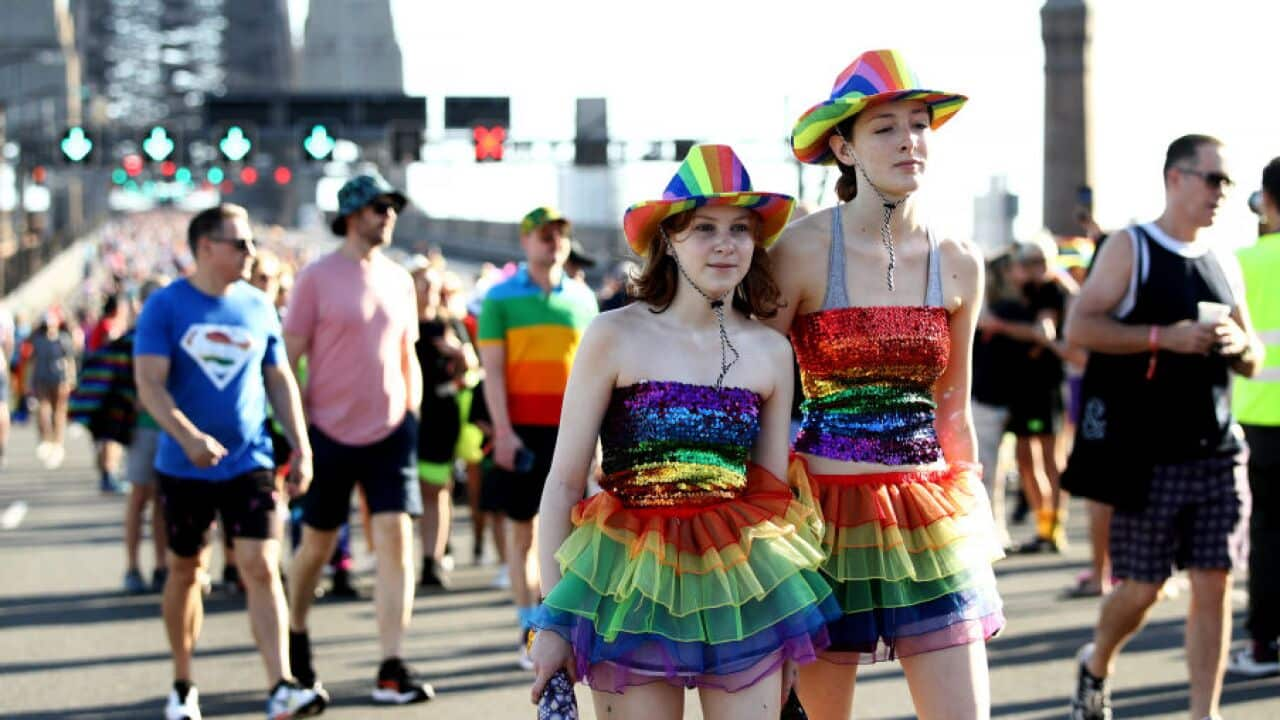Key Points
- Allies can be supportive year-round not just on certain commemoration days.
- Members of the LGBTIQ+ community say support from allies is invaluable.
- Mental health researchers say allies can help carry burdens for people.
The LGBTIQ+ community is broad and diverse and has as many different perspectives on what makes a good ally as it does people.
Allies can often feel paralysed when it comes to supporting the LGBTIQ+ community because they don’t want to say the wrong thing or step on anyone’s toes.
It helps to be flexible with new information, be ready to learn, not try to be perfect, and sit with uncomfortable moments, researcher at Australian GLBTIQ Multicultural Council Dr Maria Pallotta-Chiarolli told SBS News.
“An ally should carry some of the burden for the community — only if we are trusted to and invited,” she said.
“My question is always, ‘how can I be of use?’ That’s it.”
She said being an active ally means having active relationships with people and checking in on and supporting them.
Why allies shouldn’t ‘clock off’
International Day Against Homophobia and Transphobia (IDAHOBIT) is recognised on 17 May, which marks the date in 1990 that homosexuality was removed from the World Health Organization’s Classification of Diseases.
Many people are active, visible allies on IDAHOBIT and during Pride Month, which is marked globally in June.
Pride Month honours the 1969 Stonewall uprising in New York, which was a major turning point for the gay liberation movement globally, led by black trans women in response to police raids.
But after Pride Month, some allies drop off, youth mental health researcher at medical research centre Telethon Kids, Xander Bickendorf, told SBS News.
Participants take part in the 45th annual Gay and Lesbian Mardi Gras parade on Oxford Street in Sydney in February this year. Source: AAP / Paul Braven
“After the parades are over and the glitter settles, queer people are still queer people,” he said.
“We can’t tuck our identities away … and the people who work hard at trying to undermine our rights, don’t clock off either. So neither should an ally.”
Being visible is a good start
An important part of being an ally is being visible in real life and on social media, Bickendorf said.
“I encourage people to celebrate queer joy, to engage with queer content online, participate in community events, beyond pride month, and don’t always focus on the negativity.
“Celebrate with LGBTIQ+ people, because there are so many things out there worth celebrating,” he said.
He said allyship was not about being performative and could include calling out homophobia and transphobia wherever one sees it.
Bickendorf recommended if people are educating themselves on queer histories and experiences, to look out for unreliable sources.
“Your biggest red flag is when it’s somebody talking about trans people, rather than trans people talking. So the best possible resources on trans people, surprise, tend to be trans people.”
The best research and resources on queer people either involve those people, uplift their voices, or are spoken directly from those people, he said.
People attend the Rainbow Republic Closing Party as part of the 2023 WorldPride festival in Sydney in February. Source: AAP / Steven Saphore
Allies can make themselves visible by wearing clothes, lanyards or stickers with positive messaging and rainbow or pride flag symbols.
“I love all the rainbow stuff,” Pallotta-Chiarolli said, “but it has to go deeper”.
“Start with visibility, show the world that you are an ally. And then it becomes deeper. Ask: ‘How can I stand with you?'”
She said to be welcomed into queer spaces was “incredible” but “it’s also not about voyeurism and fetishizing, or exoticising.”
“Build relationships, show people you’re real. You’re not going to be trusted overnight. You’ve got to build trust as an active ally, who will turn up to something.”
Pallotta-Chiarolli suggested simple, practical things allies can do are helping with set up, transport and logistics of events, or helping LGBTIQ+ organisations or people with admin and communications.
Also, “doing things like speaking to people on behalf of people who might have had more wear and tear”.
Share your pronouns to show support
Another simple thing allies can do is share their pronouns whenever they meet someone, on social media and at work, Bickendorf said.
“For myself, someone who is more or less constantly misgendered, I have to share my pronouns.”
When cisgender people (those whose gender identity aligns with the gender they were assigned at birth) volunteer their pronouns first, “it normalises the idea and opens the conversation”.
“You’re immediately saying from the outset, ‘I’m a safe person to be around, I have an understanding of pronouns, and I am open and respectful of other people’s pronouns’.”
Bickendorf said there is “so much pride and value in being an ally.”
“We do want to share space with allies and share queer joy. We need more of that now than ever.”


